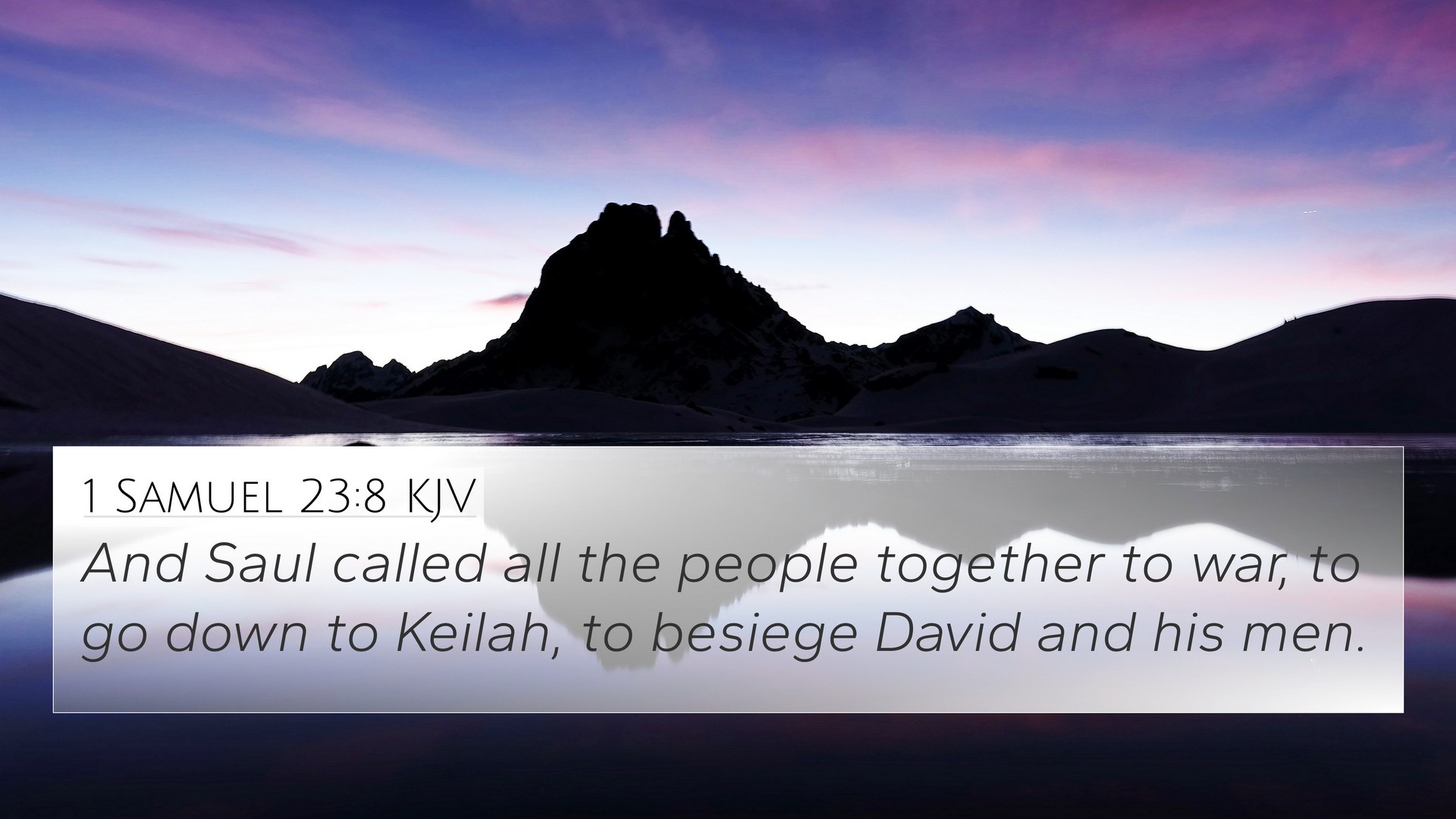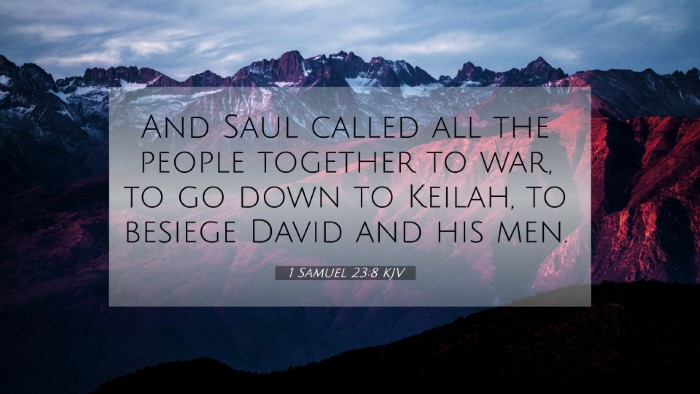Understanding 1 Samuel 23:8
Verse: 1 Samuel 23:8 - "Then Saul summoned all the people to go to war, to go down to Keilah, to besiege David and his men."
Summary and Interpretation
In this verse, we see King Saul taking action against David, who is seen as a rival to his throne. This passage is pivotal in understanding the escalating conflict between Saul and David, as Saul is actively seeking David to eliminate the perceived threat.
The motivations of Saul, his desperation to maintain power, and his willingness to pursue David even into dangerous territory highlight the themes of jealousy and fear that permeate this portion of the biblical narrative.
Insights from Commentaries
Matthew Henry's Commentary
Henry highlights the urgency in Saul’s actions as he gathers all the Israelites to pursue David. This reflects Saul's increasing paranoia and his determination to eliminate David, whom he believes is competing for his kingship.
Albert Barnes' Commentary
Barnes points out the geographical significance of Keilah, a city fortified against invaders. Saul’s intent to besiege David in a stronghold indicates his strategic but desperate measures to secure his reign and exemplifies his military capabilities despite his declining mental state.
Adam Clarke's Commentary
Clarke emphasizes the moral implications of Saul’s actions. He discusses the stark contrast between Saul’s growing madness and David’s increasingly righteous path, marking a divide between the anointed king of Israel and God's purpose with David.
Bible Verse Cross-References
- 1 Samuel 18:12 - "Saul was afraid of David because the Lord was with David but had departed from Saul." This verse establishes the reason for Saul’s fear and subsequent actions against David.
- 1 Samuel 19:1 - "Saul told his son Jonathan and all the attendants to kill David." This continues the narrative of Saul’s pursuit and the lengths to which he would go.
- 1 Samuel 23:14 - "And David stayed in the wilderness strongholds, and remained in the hill country in the wilderness of Ziph." This shows the direct aftermath of Saul’s plans to capture him.
- Psalm 59:1-2 - A prayer of David, relating to his flight from Saul, further indicating the turmoil he faced during this time.
- Proverbs 29:2 - "When the righteous thrive, the people rejoice; when the wicked rule, the people groan." This thematic parallel reflects the state of Israel under Saul.
- 1 Samuel 24:10 - "This day you have seen with your own eyes how the Lord delivered you into my hands in the cave; I said, 'I will not lay a hand on the Lord's anointed.'" This highlights David’s restraint, contrasting Saul’s aggression.
- 1 Samuel 26:2 - "So Saul went down to the Desert of Ziph with his three thousand select Israelite troops to search for David there." This reference continues to illuminate Saul's relentless pursuit of David.
- Acts 13:22 - "After removing Saul, he made David their king." This New Testament connection emphasizes God's sovereignty in choosing David despite the conflict depicted in Samuel.
- Hebrews 11:32-34 - This passage mentions David as a figure of faith, underscoring the conflicts he faced, including those with Saul.
Connections Between Bible Verses
The account of Saul's pursuit of David in 1 Samuel 23:8 must be understood in the broader context of biblical themes of leadership, the sovereignty of God, and the contrast between righteous and wicked rulers. The connections between these verses create a deeper understanding of God's unfolding plan for Israel and the establishment of David’s monarchy.
Thematic Bible Verse Connections
This passage connects not only within the books of Samuel but also resonates throughout both the Old and New Testaments, providing insight into the nature of divine appointment and the challenges faced by those chosen by God.
Conclusion
1 Samuel 23:8 is significant for its portrayal of Saul's character and the unfolding narrative of David's rise to kingship against the backdrop of divine providence. By exploring these connections and references, readers can gain a comprehensive understanding of the text and its implications for faith and leadership.


